Assessment of Energy Use and Photovoltaic Energy Potential in Saudi Arabian Governmental Schools
Abstract
1. Introduction
- The PV rooftop integrations to three school buildings in the Qassim area with actual measurements and readings.
- PV degradation and the expected increase in annual demand are considered in the current analysis.
- Two zero-energy and zero-utility techniques along the system’s life cycle are analyzed and compared.
- This analysis calculates and considers key indicators, such as EUI and CPC.
2. Literature Review
3. Methodology
3.1. Meteorological Conditions
3.2. Energy Consumption and Indicators
3.3. Technical and Economic Analysis of PV Systems
3.4. Environmental Analysis of PV Systems
4. Results and Discussions
4.1. Electricity Consumption and Indicators
4.2. End-Use Electricity Consumption
4.3. PV Systems Analysis
4.3.1. Zero-Energy Balance Scenario
4.3.2. Zero-Bill Scenario
4.3.3. Tariff Sensitivity Analysis
4.4. Environmental Benefits of PV Systems
5. Conclusions and Recommendations
Author Contributions
Funding
Institutional Review Board Statement
Informed Consent Statement
Data Availability Statement
Acknowledgments
Conflicts of Interest
Abbreviations
| AC | air conditioning |
| CDD | cooling-degree days |
| CPC | consumption per capita |
| DG | diesel-generating |
| EF | emissions factor |
| EUI | energy use intensity |
| GHG | greenhouse gas |
| HDD | heating-degree days |
| KSA | Kingdom of Saudi Arabia |
| LCOE | levelized cost of energy |
| PR | performance ratio |
| PV | photovoltaic |
| RE | renewable energy |
| SAR | Saudi riyal |
| SPBP | payback period |
References
- Education Statistics and Decision Support Center. 2023. Available online: https://departments.moe.gov.sa/Statistics/Educationstatistics/Pages/GEStats.aspx (accessed on 11 November 2024).
- Information and Statistics. 2022. Available online: https://moe.gov.sa/ar/pages/default.aspx (accessed on 5 October 2024).
- Basic Law of Governance, Article 30; Bureau of Experts at the Council of Ministers Official Translation Department: Riyadh, Saudi Arabia, 1992; p. 14. Available online: https://laws.boe.gov.sa/Files/Download/?attId=ed4842e1-9543-40b9-973b-ada200d4ed10 (accessed on 5 October 2024).
- Alfaraidy, F.A.; Sulieman, H.A. The Economics of Using Solar Energy: School Buildings in Saudi Arabia as a Case Study. ARO-Sci. J. Koya Univ. 2019, 7, 13–18. [Google Scholar] [CrossRef]
- Alwetaishi, M.; Balabel, A. Numerical study of micro-climatically responsive school building design in Saudi Arabia. J. King Saud Univ.-Eng. Sci. 2019, 31, 224–233. [Google Scholar] [CrossRef]
- Abanomi, W.M. Environmental Design of Prototype School Buildings in Hot, Arid Regions with Special Reference to Riyadh, Saudi Arabia. Ph.D. Dissertation, Cardiff University, Cardiff, UK, 2005. [Google Scholar]
- Dias Pereira, L.; Raimondo, D.; Corgnati, S.P.; da Silva, M.G. Energy consumption in schools—A review paper. Renew. Sustain. Energy Rev. 2014, 40, 911–922. [Google Scholar] [CrossRef]
- Lizana, J.; Serrano-Jimenez, A.; Ortiz, C.; Becerra, J.A.; Chacartegui, R. Energy assessment method towards low-carbon energy schools. Energy 2018, 159, 310–326. [Google Scholar] [CrossRef]
- Ahamad, A.H.; Abidin, N.I.; Zakaria, R.; Aminudin, E.; Khan, J.S.; Sahamir, S.R.; Azman, S.; Redzuan, A.A.; Lau, S.E.N.; Yusoff, M.F.M. School Building Energy Assessment Using Lean Energy Management Strategies. Front. Built Environ. 2022, 7, 679579. [Google Scholar] [CrossRef]
- Basarir, B.; Diri, B.S.; Diri, C.J.R. Energy efficient retrofit methods at the building envelopes of the school buildings. In Proceedings of the Retrofit Conference, Manchester, UK, 24–26 January 2012; pp. 1–13. [Google Scholar]
- Ali, H.; Hashlamun, R. Envelope retrofitting strategies for public school buildings in Jordan. J. Build. Eng. 2019, 25, 100819. [Google Scholar]
- Al-Tamimi, N.; Qahtan, A.; Alotaibi, B.S.; Abuhussain, M.A. Innovative retrofitting approaches for energy saving in Saudi public schools. Indoor Built Environ. 2024, 33, 1260–1279. [Google Scholar] [CrossRef]
- Alaidroos, A.; Almaimani, A.; Krarti, M.; Qurnfulah, E.; Tiwari, A. Influence of building envelope characteristics on the effectiveness of PMV-based controls for schools located in Saudi Arabia. Indoor Built Environ. 2022, 31, 2411–2429. [Google Scholar] [CrossRef]
- Saeed, S.A.R. Energy conservation strategies for school buildings in Riyadh. Int. J. Ambient. Energy 1997, 18, 43–52. [Google Scholar]
- Al-Tamimi, N. An Optimum Thermal Insulation Type and Thickness for Residential Buildings in Three Different Climatic Regions of Saudi Arabia. Civ. Eng. Archit. 2021, 9, 317–327. [Google Scholar] [CrossRef]
- Alwetaishi, M.; Al-Khatri, H.; Benjeddou, O.; Shamseldin, A.; Alsehli, M.; Alghamdi, S.; Shrahily, R. An investigation of shading devices in a hot region: A case study in a school building. Ain Shams Eng. J. 2021, 12, 3229–3239. [Google Scholar] [CrossRef]
- Zomorodian, Z.S.; Nasrollahi, F. Architectural Design Optimization of School Buildings for Reduction of Energy Demand in Hot & Dry Climates of Iran. Int. J. Archit. Eng. Urban Plan. 2013, 23, 41–50. [Google Scholar]
- Al-Tamimi, N. Building Envelope Retrofitting Strategies for Energy-Efficient Office Buildings in Saudi Arabia. Buildings 2022, 12, 1900. [Google Scholar] [CrossRef]
- Aloshan, M.; Aldali, K. Empirical study of facade retrofits for optimizing energy efficiency and cooling in school buildings in Saudi Arabia. Energy Rep. 2024, 12, 4105–4128. [Google Scholar]
- Charles, J.; Huayra-Armas, A.L.; Atao-Rivas, Y.; Quispe-López, C.; Michael, M.; Justiniano-Medina, A. Towards a Sustainable Campus: Design and Evaluation of a Photovoltaic System for a Secondary School. In Proceedings of the 8th International Conference on Industrial, Mechanical, Electrical and Chemical Engineering (ICIMECE 2023), Lombok, Nusa Tenggara Barat, Indonesia, 30–31 October 2023. [Google Scholar]
- Haffaf, A.; Lakdja, F.; Meziane, R.; Abdeslam, D. Promotion and effective integration of school rooftop PV system based load management activities: A case study. Int. J. Sustain. Dev. Plan. 2020, 15, 501–511. [Google Scholar] [CrossRef]
- Emmanuel, M.; Akinyele, D.; Rayudu, R. Techno-economic analysis of a 10 kWp utility interactive photovoltaic system at Maungaraki school, Wellington, New Zealand. Energy 2017, 120, 573–583. [Google Scholar]
- Kim, J.-Y.; Jeon, G.-Y.; Hong, W.-H. The performance and economical analysis of grid-connected photovoltaic systems in Daegu, Korea. Appl. Energy 2009, 86, 265–272. [Google Scholar] [CrossRef]
- Abdillah, M.; Satria, F.M.; Pertiwi, N.I.; Setiadi, H. Design of photovoltaic system for public school building. Indones. J. Electr. Eng. Comput. Sci. 2023, 29, 56–65. [Google Scholar] [CrossRef]
- Bilir, L.; Yildirim, N. Photovoltaic system assessment for a school building. Int. J. Hydrog. Energy 2017, 42, 17856–17868. [Google Scholar] [CrossRef]
- Bakri, J.A.; Badmus, I.; Hammed, S.O. Comparative Assessment of Solar Photovoltaic System and Diesel Generating Set for Energy Sustainability in Engineering Buildings of Yaba College of Technology. Eur. J. Energy Res. 2022, 2, 10–16. [Google Scholar]
- Allouhi, A.; Saadani, R.; Kousksou, T.; Saidur, R.; Jamil, A.; Rahmoune, M. Grid-connected PV systems installed on institutional buildings: Technology comparison, energy analysis and economic performance. Energy Build. 2016, 130, 188–201. [Google Scholar] [CrossRef]
- Ibrik, I.; Hashaika, F. Techno-Economic Impact of Grid-Connected Rooftop Solar PV System for Schools in Palestine: A Case Study of Three Schools. Int. J. Energy Econ. Policy 2019, 9, 291–300. [Google Scholar]
- Husain, A.; Jawad, S. Solar Photovoltaic Systems on Public Schools Buildings: A Case Study in Palestine. Am. J. Electr. Power Energy Syst. 2021, 10, 1–5. [Google Scholar]
- Al-Otaibi, A.; Al-Qattan, A.; Fairouz, F.; Al-Mulla, A. Performance evaluation of photovoltaic systems on Kuwaiti schools’ rooftop. Energy Convers. Manag. 2015, 95, 110–119. [Google Scholar]
- Hajiah, A.E.; Khatib, T.; Sopian, K.; Sebzali, M. Performance of grid-connected photovoltaic system in two sites in kuwait. Int. J. Photoenergy 2012, 2012, 1–7. [Google Scholar] [CrossRef]
- Kazem, H.A.; Khatib, T. Techno-economical assessment of grid connected photovoltaic power systems productivity in Sohar, Oman. Sustain. Energy Technol. Assess. 2013, 3, 61–65. [Google Scholar]
- Alfaoyzan, F.A.; Almasri, R.A. Utilizing solar photovoltaic systems in educational facilities to achieve a zero bill campus: The Sulaiman Al-Rajhi University case. Energy Explor. Exploit. 2023, 41, 1415–1438. [Google Scholar]
- Tazay, A. Techno-Economic Feasibility Analysis of a Hybrid Renewable Energy Supply Options for University Buildings in Saudi Arabia. Open Eng. 2021, 11, 39–55. [Google Scholar]
- Baseer, M.A.; Alqahtani, A.; Rehman, S. Techno-economic design and evaluation of hybrid energy systems for residential communities: Case study of Jubail industrial city. J. Clean. Prod. 2019, 237, 117806. [Google Scholar]
- Al-Anazi, M.A.; Almasri, R.A. Evaluation of potential capabilities of energy savings and utilization of solar energy in mosques in Hail city, Kingdom of Saudi Arabia. Energy Explor. Exploit. 2023, 41, 1051–1084. [Google Scholar] [CrossRef]
- Alfaoyzan, F.A.; Almasri, R.A. Benchmarking of Energy Consumption in Higher Education Buildings in Saudi Arabia to Be Sustainable: Sulaiman Al-Rajhi University Case. Energies 2023, 16, 1204. [Google Scholar] [CrossRef]
- Al-Fouzan, A.A.; Almasri, R.A. A Sustainable Solution for Urban Transport Using Photovoltaic Electric Vehicle Charging Stations: A Case Study of the City of Hail in Saudi Arabia. Appl. Sci. 2024, 14, 5422. [Google Scholar] [CrossRef]
- Almasri, R.A.; Al-Anazi, M.A.; Almarshoud, A.; Alshitawi, M.S.; Abu-Hamdeh, N.H. Investigating energy efficiency and solar energy in Saudi mosques to achieve zero energy or zero bill. Alex. Eng. J. 2023, 68, 263–280. [Google Scholar] [CrossRef]
- AlKassem, A.; Draou, A.; Alamri, A.; Alharbi, H. Design Analysis of an Optimal Microgrid System for the Integration of Renewable Energy Sources at a University Campus. Sustainability 2022, 14, 4175. [Google Scholar] [CrossRef]
- Almarshoud, A.F. Technical and Economic Performance of 1MW Grid-connected PV system in Saudi Arabia. Int. J. Eng. Res. Appl. 2017, 7, 9–17. [Google Scholar] [CrossRef]
- Saudi Building Energy Conservation Code-Residential SBC 602; Saudi Building Code National Committee: Riyadh, Saudi Arabia, 2018; p. 64. Available online: https://www.sbc.gov.sa/En/BuildingCode/Pages/SBC_602E.aspx (accessed on 26 February 2025).
- Almasri, R.A.; Akram, R.; Almarshoud, A.; Omar, H.M.; Alshitawi, M.S.; Esmaeil, K.K. Evaluation of the total exergy and energy consumptions in residential sector in Qassim Region, Saudi Arabia. Alex. Eng. J. 2022, 62, 455–473. [Google Scholar] [CrossRef]
- Almotairy, F.H.; Almarshoud, A.F. Achieving zero-bill for the grid-connected PV systems in Saudi Arabia governmental schools: A techno-economic analysis. Future Energy 2024, 3, 14–23. [Google Scholar] [CrossRef]
- Abdulkareem, A.; Ellaboudy, A. Saudi Arabia News Brief and Action Alert, Saudi Electricity Company. 2023. Available online: https://www.climatescorecard.org/2023/01/saudi-electricity-company/ (accessed on 28 October 2024).
- Ghenai, C.; Bettayeb, M. Modelling and performance analysis of a stand-alone hybrid solar PV/Fuel Cell/Diesel Generator power system for university building. Energy 2019, 171, 180–189. [Google Scholar] [CrossRef]
- Degree Days Calculated Accurately for Locations Worldwide. 2024. Available online: https://www.degreedays.net/ (accessed on 18 October 2024).
- Solar Panel Cost. 2023. Available online: https://www.solar.com/learn/solar-panel-cost/ (accessed on 9 November 2024).
- Das, M.; Singh, M.N.K.; Biswas, A. Techno-economic optimization of an off-grid hybrid renewable energy system using metaheuristic optimization approaches—Case of a radio transmitter station in India. Energy Convers. Manag. 2019, 185, 339–352. [Google Scholar] [CrossRef]
- Gaabour, A.; Metatla, A.; Kelaiaia, R.; Bourennani, F.; Kerboua, A. Recent bibliography on the optimization of multi-source energy systems. Arch. Comput. Methods Eng. 2019, 26, 809–830. [Google Scholar] [CrossRef]
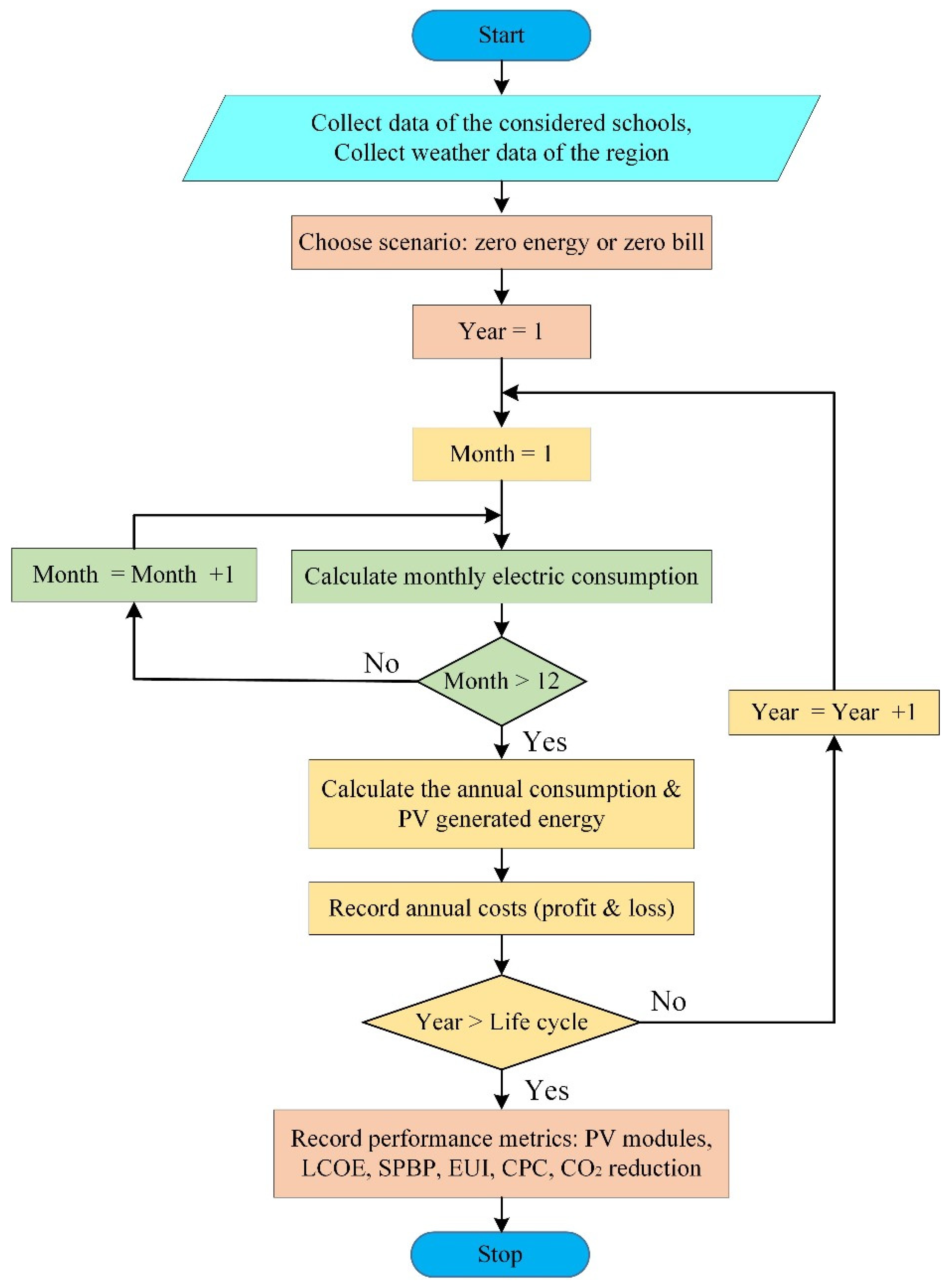
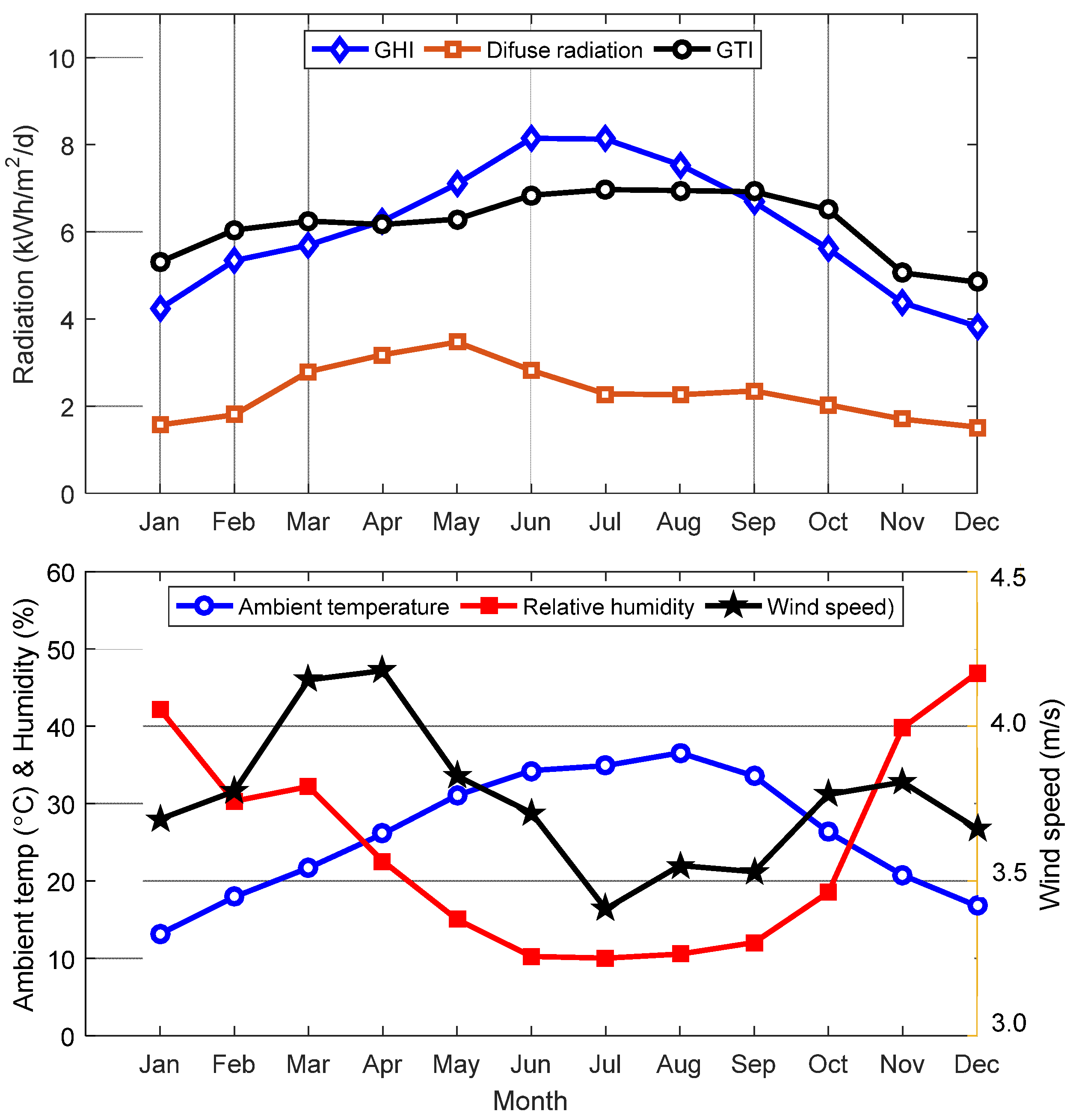

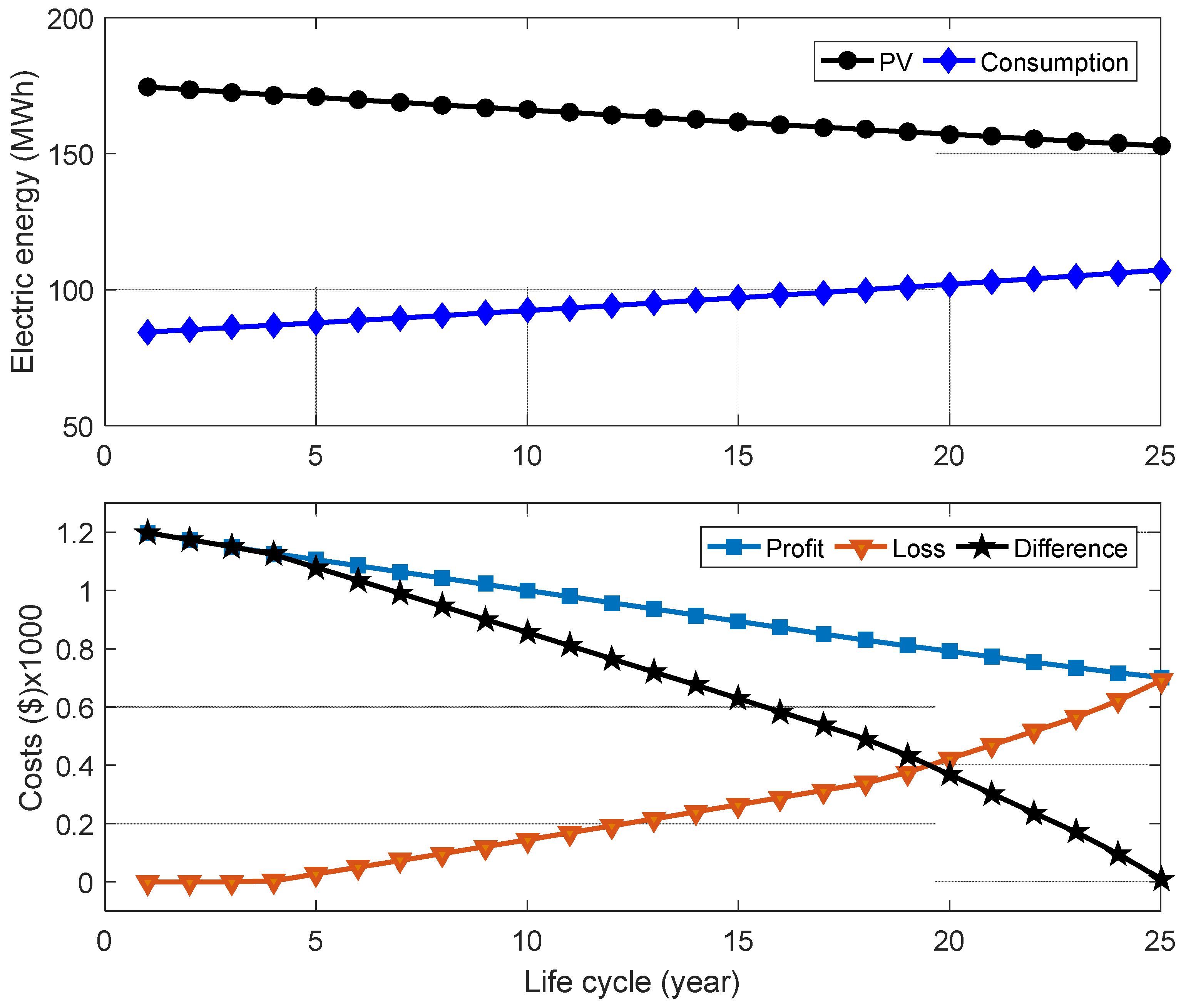

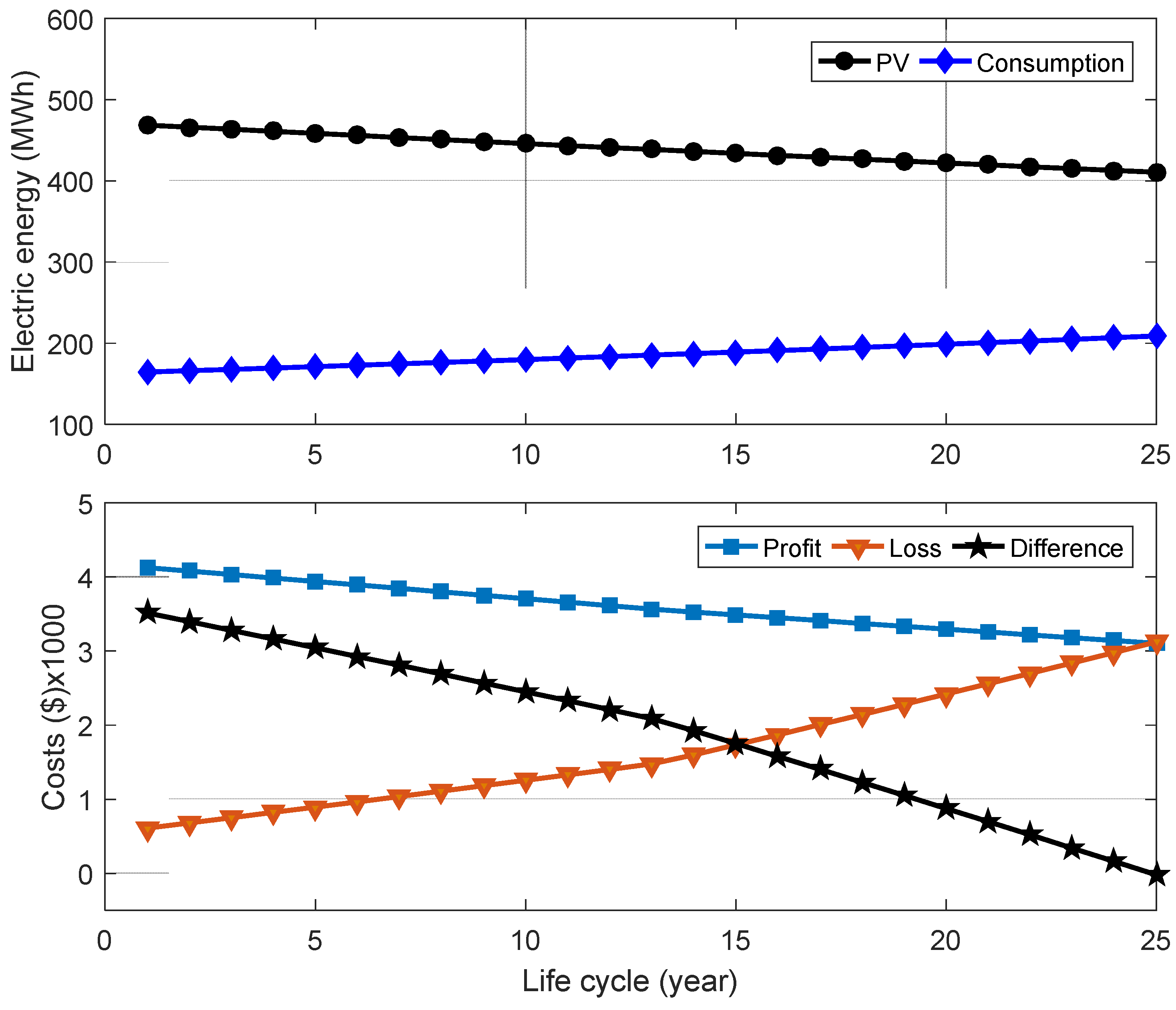
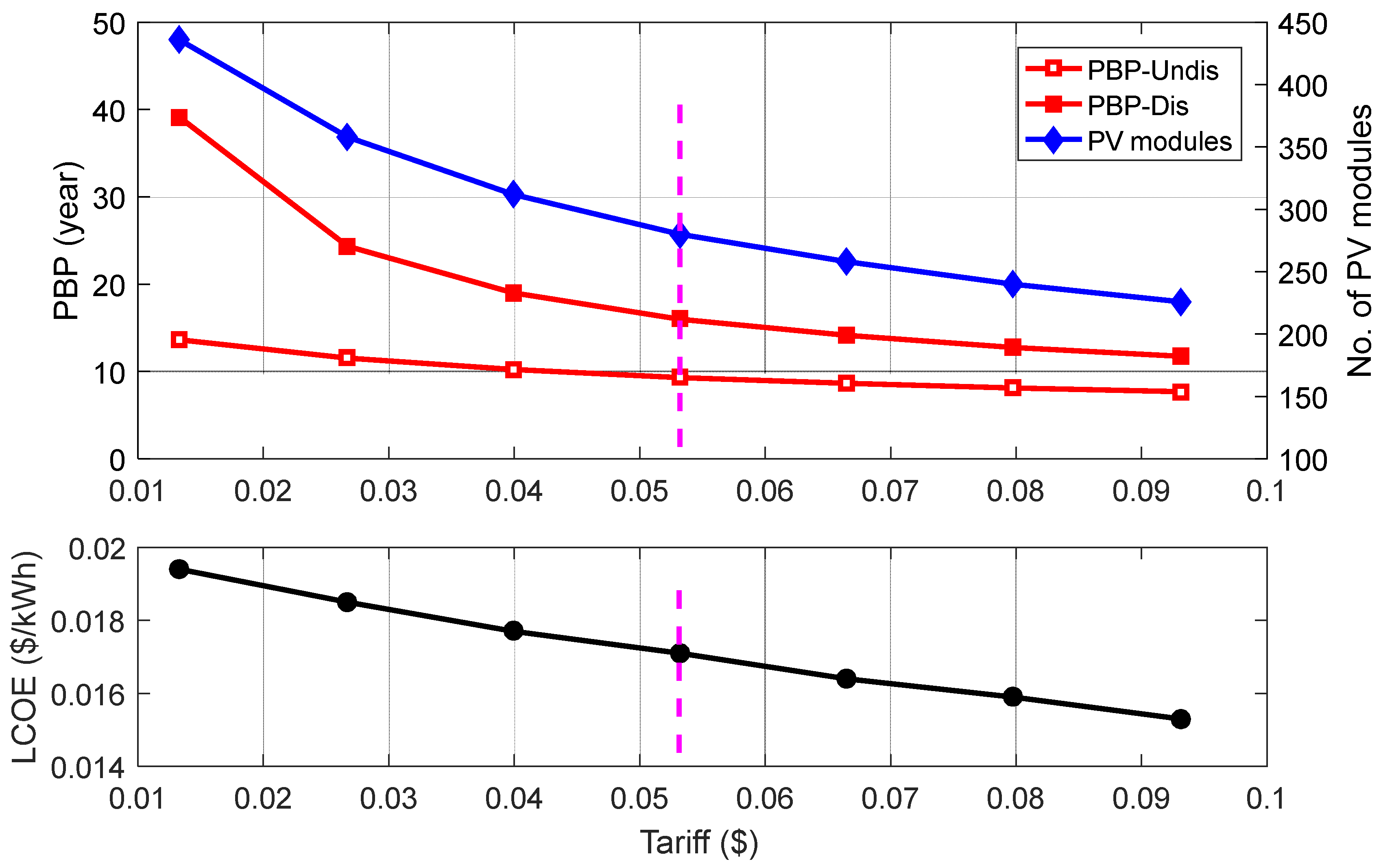
| Application and Location | System, Capacity (kWP) | SPBP (Years) | LCOE ($/kWh) | References, Date |
|---|---|---|---|---|
| Mutla and Al-Wafra, Kuwait | Grid-connected PV systems, 100.0 | 15.00 | 0.100 | Hajiah et al. [31], 2012 |
| Sohar University campus in Sohar, Oman | Grid-connected PV systems, 3.08 | - | 0.158 | Kazem and Khatib [32], 2013 |
| At Sulaiman Al-Rajhi University, KSA | Grid-connected PV systems, 1200.0 and 5300.0 | 8.10–10.00 | 0.026–0.028 | Alfaoyzan and Almasri [33,37], 2023 |
| Colleges in KSA | Hybrid RE system, 62.0 | 17.00 | 0.0688–0.0753 | Tazay [34], 2021 |
| Jubail Industrial City, KSA | On-off-grid-connected PV/wind/DG, 685.0, 463.0, and 270.0 | - | 0.183–0.244 | Baseer et al. [35], 2019 |
| Electric vehicle charging stations in Hail City, KSA | Grid-connected PV systems, 1047.35 | 11.69 | 0.022 | Al-fouzan and Almasri [38], 2024 |
| Mosques in Qassim region, KSA | Grid-connected PV systems, 12.0 and 17.0 | 3.70–4.10 | - | Almasri et al. [39], 2023 |
| Mosques in Hail City, KSA | Grid-connected PV systems, 18.0 and 72.0 | 5.14 | 0.024 | Al-Anazi and Almasri [36], 2023 |
| School in Arar City, KSA | Grid-connected PV systems, 150.0 | 8.26 | - | Alfaraidy and Sulieman [4], 2019 |
| Islamic University of Madinah, KSA | PV system, 1500.0 | 18.60 | 0.051 | AlKassem et al. [40], 2022 |
| Power plant in Qassim region, KSA | Grid-connected PV systems, 1000.0 | 13.70 | 0.036 | Almarshoud [41], 2017 |
| Month | School 1 (kWh/Month) | School 2 (kWh/Month) | School 3 (kWh/Month) |
|---|---|---|---|
| 1 | 6069 | 17,046 | 9359 |
| 2 | 5758 | 10,289 | 7157 |
| 3 | 4980 | 14,281 | 2753 |
| 4 | 6640 | 17,813 | 2753 |
| 5 | 4254 | 30,252 | 23,672 |
| 6 | 4669 | 18,274 | 6056 |
| 7 | 4358 | 6450 | 6606 |
| 8 | 12,139 | 54,361 | 34,682 |
| 9 | 14,836 | 57,126 | 48,445 |
| 10 | 10,998 | 8446 | 7707 |
| 11 | 5810 | 20,577 | 3303 |
| 12 | 3891 | 22,343 | 12,111 |
| Annual Electrical Energy Consumption (kWh) | EUI (kWh/m2) | CPC (kWh/Capita) | |
|---|---|---|---|
| School 1 | 84,402 | 22 | 630 |
| School 2 | 277,259 | 37 | 417 |
| School 3 | 164,603 | 48 | 337 |
| CDD (°C-Day) | HDD | AC (%) | Light (%) | Other (%) | Reference—Date | |
|---|---|---|---|---|---|---|
| School buildings in Qassim, KSA | 1972 | 588 | 80 | 11 | 9 | Present case |
| School buildings in Arar City, KSA | 2419 | 390 | 71 | 9 | 20 | Alfaraidy and Sulieman [4]—2019 |
| Supervision Building, University of Sharjah, UAE | 2391 | 44 | 72 | 10 | 18 | Ghenai and Bettayeb [46]—2019 |
| Sulaiman Al-Rajhi University in Qassim, KSA | 1972 | 588 | 79 | 7 | 14 | Alfaoyzan and Almasri [37]—2023 |
| Parameter | School 1 | School 2 | School 3 | |
|---|---|---|---|---|
| Annual load (kWh/year) | 84,402 | 277,259 | 164,603 | |
| Available roof area (m2) | 1646 | 3532 | 1391 | |
| Maximum number of PV modules on the roof | 351 | 782 | 290 | |
| Installed modules number | 116 | 374 | 222 | |
| PV Peak power (kW) | 63.8 | 205.7 | 122.1 | |
| SPBP (year) | Undiscounted | 7.69 | 7.56 | 7.56 |
| Discounted | 11.75 | 11.46 | 11.46 | |
| LCOE ($/kWh) | 0.0229 | 0.0252 | 0.0249 | |
| Annual yield factor (kWh/kWP) | 1950 | 1994 | 1994 | |
| Capacity factor (%) | 22.26 | 22.33 | 22.33 | |
| Performance ratio (%) | 86.81 | 88.84 | 88.84 | |
| Parameter | School 1 | School 2 | School 3 | |
|---|---|---|---|---|
| Load (kWh/year) | 84,402 | 277,259 | 164,603 | |
| Maximum number of PV modules on the roof | 351 | 782 | 290 | |
| Installed modules number | 166 | 622 | 436 | |
| PV Peak power (kW) | 91.3 | 342.1 | 239.8 | |
| SPBP (year) | Undiscounted | 10.58 | 11.85 | 13.64 |
| Discounted | 20.24 | 25.93 | 39.14 | |
| LCOE ($/kWh) | 0.0223 | 0.0184 | 0.0194 | |
| Zero-Energy Scenario | Zero-Bill Scenario | |||||
|---|---|---|---|---|---|---|
| Installed Modules Number | PV-Generated Electricity (MWh) | Reduction of CO2 (Tonne) | Installed Modules Number | PV-Generated Electricity (MWh) | Reduction of CO2 (Tonne) | |
| School 1 | 116 | 2855.1 | 1624.5 | 166 | 4085.7 | 2324.8 |
| School 2 | 374 | 9411.5 | 5355.1 | 622 | 15,652.3 | 8906.1 |
| School 3 | 222 | 5586.5 | 3178.7 | 436 | 10,971.7 | 6242.9 |
| Total | 712 | 17,853.1 | 10,158.4 | 1224 | 30,709.7 | 17,473.8 |
| Average per school | 238 | 5951.0 | 3386.1 | 408 | 10,236.6 | 5824.6 |
| Zero-Energy Scenario | Zero-Bill Scenario | |||
|---|---|---|---|---|
| PV-Generated Electricity (MWh) | Reduction of CO2 (Tonne) | PV-Generated Electricity (MWh) | Reduction of CO2 (Tonne) | |
| Average per school | 5951.0 | 3386.1 | 10,236.6 | 5824.6 |
| Total in KSA | 143,270,325 | 81,520,358 | 246,446,145 | 140,227,245 |
Disclaimer/Publisher’s Note: The statements, opinions and data contained in all publications are solely those of the individual author(s) and contributor(s) and not of MDPI and/or the editor(s). MDPI and/or the editor(s) disclaim responsibility for any injury to people or property resulting from any ideas, methods, instructions or products referred to in the content. |
© 2025 by the authors. Licensee MDPI, Basel, Switzerland. This article is an open access article distributed under the terms and conditions of the Creative Commons Attribution (CC BY) license (https://creativecommons.org/licenses/by/4.0/).
Share and Cite
Almasri, R.A.; Eid, A.; Almarshoud, A.F.; Almotairy, F.H. Assessment of Energy Use and Photovoltaic Energy Potential in Saudi Arabian Governmental Schools. Appl. Sci. 2025, 15, 3809. https://doi.org/10.3390/app15073809
Almasri RA, Eid A, Almarshoud AF, Almotairy FH. Assessment of Energy Use and Photovoltaic Energy Potential in Saudi Arabian Governmental Schools. Applied Sciences. 2025; 15(7):3809. https://doi.org/10.3390/app15073809
Chicago/Turabian StyleAlmasri, Radwan A., Ahmad Eid, A. F. Almarshoud, and F. H. Almotairy. 2025. "Assessment of Energy Use and Photovoltaic Energy Potential in Saudi Arabian Governmental Schools" Applied Sciences 15, no. 7: 3809. https://doi.org/10.3390/app15073809
APA StyleAlmasri, R. A., Eid, A., Almarshoud, A. F., & Almotairy, F. H. (2025). Assessment of Energy Use and Photovoltaic Energy Potential in Saudi Arabian Governmental Schools. Applied Sciences, 15(7), 3809. https://doi.org/10.3390/app15073809







